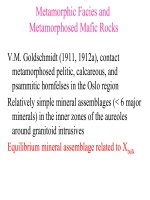Metamorphic rock and rock cycle
Bạn đang xem bản rút gọn của tài liệu. Xem và tải ngay bản đầy đủ của tài liệu tại đây (563.18 KB, 13 trang )
Metamorphic Rock
& The Rock Cycle
Chapter 3 in Prentice Hall
Metamorphic Rock
• Every metamorphic rock
is a rock that has
changed its form
• “Metamorphic” means
“changed form”
Metamorphic Rock
• Heat and pressure deep beneath
Earth’s surface can change any rock
into metamorphic rock.
• Sometimes, forces inside the Earth can
push the rock down toward the heat of
the mantle.
/>
Metamorphic Rock
Metamorphic Rock video
Metamorphic Rock
• When rock changes into
metamorphic rock, its
appearance, texture, crystal
structure and mineral content
change
• Metamorphic rock can form out
of igneous, sedimentary, or
other metamorphic rock.
Metamorphic Rock
• Geologists classify metamorphic rocks
by the arrangement of the grains that
make up the rocks.
– If grains are lined up in parallel layers or
bands, they are said to be foliated.
Banded gneiss
is foliated
Banded gneiss photo from
/>
Metamorphic Rock
Slate
Schist
/>
Quartzite
/>
o/images/quartzite.jpg
Metamorphic Rock
Igneous or
Sedimentary
Granite
Shale
Sandstone
Limestone
Metamorphic
Gneiss
Slate
Quartzite
Marble
The Rock Cycle
• Forces inside Earth and at the
surface produce a rock cycle that
builds, destroys, and changes the
rocks in the crust
• The rock cycle is a series of
processes on and beneath Earth’s
surface that slowly changes rock
from one form to another.
o of Prentice Hall Science Explorer:
• The rock cycle can follow many different
pathways, here is one example:
• The intrusive igneous rock, granite could
have formed under the Earth’s surface, then
been pushed up forming a mountain. The
process of weathering by wind or water or
other forces, then erosion and deposition
could carry granite particles away and start
the formation of sedimentary sandstone .
• After piling up many layers, the sandstone
could be pushed deep into the Earth where
heat and pressure turn it into the
metamorphic rock, quartzite. The quartzite,
granite, or sandstone could be forced deeper
into the Earth where it melts to move toward
the Earth’s surface as magma then possibly
lava. I hope this slide didn’t give you a headache!!
Rock Cycle Question
• When the Earth first formed and was a
new planet, what type of rock would you
think was the first to form?
IGNEOUS
Rock review question
• What is the most common coarse-grained
igneous rock? Remember coarse-grained
means it has large grains, and large
grains are formed when igneous rock
cools slowly below the Earth’s surface.
• Granite
• What kind of texture will a conglomerate
rock have?
• Rounded









